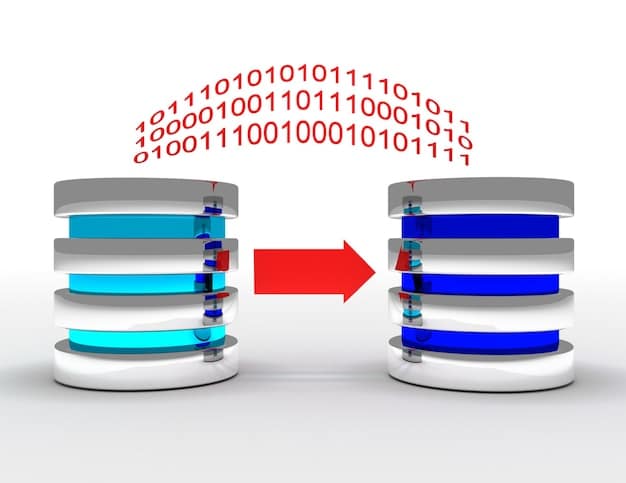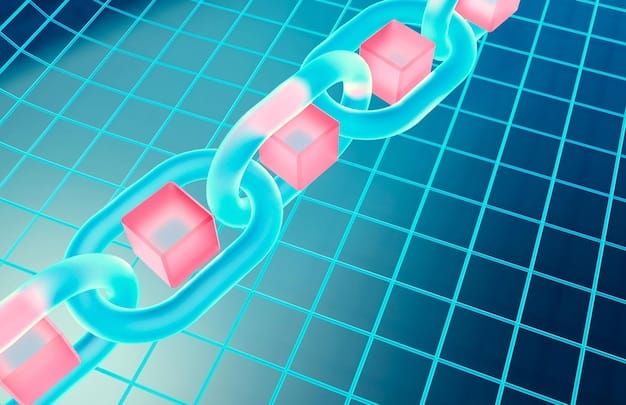Blockchain Scalability in 2025: Layer-2 Tech Comparison for High Throughput

Blockchain scalability solutions, particularly layer-2 technologies like rollups, sidechains, and state channels, are crucial for achieving high-throughput applications by 2025, addressing the limitations of layer-1 blockchains and enabling broader adoption.
The blockchain’s promise of decentralization and security often clashes with its scalability limitations. Exploring blockchain scalability solutions: comparing layer-2 technologies for high-throughput applications in 2025, is becoming increasingly vital. Let’s delve into how layer-2 technologies aim to overcome these hurdles.
Understanding the Blockchain Scalability Problem
Blockchain technology, while revolutionary, faces significant challenges in handling large volumes of transactions. This is commonly referred to as the scalability problem, which directly impacts the user experience and the potential for widespread adoption.
The Limitations of Layer-1 Blockchains
Layer-1 blockchains, like Bitcoin and Ethereum, process transactions directly on the main blockchain. This can lead to congestion, slow transaction speeds, and high transaction fees, especially during peak times.
The Need for Scalability Solutions
To support high-throughput applications such as decentralized finance (DeFi), gaming, and supply chain management, scalable blockchain solutions are necessary. These solutions must maintain security and decentralization while significantly increasing transaction processing capabilities.
- Increased transaction throughput: Enabling more transactions per second.
- Reduced transaction fees: Making blockchain applications more affordable.
- Improved user experience: Ensuring faster and more reliable transactions.
- Support for complex applications: Facilitating the development of sophisticated decentralized applications.
Addressing the scalability problem is critical for the blockchain to reach its full potential and become a mainstream technology.
Introduction to Layer-2 Scaling Technologies
Layer-2 scaling technologies are innovative solutions designed to enhance blockchain scalability without altering the underlying layer-1 protocol. By offloading transactions and computations to external systems, layer-2 solutions alleviate congestion and boost transaction speeds.
What are Layer-2 Solutions?
Layer-2 solutions operate on top of an existing blockchain, known as the layer-1. They handle a significant portion of the transaction processing off-chain, only interacting with the main chain for specific purposes like dispute resolution or final settlement.
Benefits of Layer-2 Scaling
The primary benefits of layer-2 scaling include improved transaction throughput, reduced fees, and enhanced user experience. They also allow for greater flexibility in application design, as developers can tailor layer-2 protocols to meet specific needs.
- Increased scalability without compromising security.
- Compatibility with existing blockchain infrastructure.
- Support for a wide range of applications and use cases.
- Potential for further optimization and innovation.
Layer-2 scaling represents a promising path toward achieving the performance levels required for widespread blockchain adoption.

Rollups: Optimistic and ZK-Rollups
Rollups are a type of layer-2 scaling solution that aggregates multiple transactions into a single batch and submits it to the layer-1 blockchain. This approach significantly reduces on-chain congestion and lowers transaction fees.
Optimistic Rollups
Optimistic rollups assume that transactions are valid unless proven otherwise. They post transaction data to the layer-1 blockchain but allow a challenge period during which anyone can dispute the validity of the transactions.
ZK-Rollups (Zero-Knowledge Rollups)
ZK-rollups use zero-knowledge proofs to verify the validity of transactions before submitting them to the layer-1 blockchain. This eliminates the need for a challenge period, resulting in faster transaction finality.
The key differences between optimistic and ZK-rollups lie in their security models and transaction finality times. Optimistic rollups offer lower computational overhead but require a challenge period, while ZK-rollups provide faster finality but are more computationally intensive. Both approaches offer substantial improvements in scalability compared to layer-1 blockchains.
- **Optimistic Rollups:**
* Lower computational costs.
* Challenge period required for dispute resolution.
* Scalability gains of up to 10-100x. - **ZK-Rollups:**
* Faster transaction finality.
* Higher computational costs due to zero-knowledge proofs.
* Scalability gains of up to 100-1000x.
Rollups represent a powerful approach to scaling blockchain applications, offering a balance between security, speed, and cost.
Sidechains: Independent Blockchains with Bridges
Sidechains are independent blockchains that run parallel to a main blockchain and are connected to it via a two-way bridge. This allows assets and data to be transferred between the main chain and the sidechain, enabling greater scalability and flexibility.
How Sidechains Work
Sidechains have their own consensus mechanisms and block parameters, allowing them to process transactions much faster than the main chain. They periodically anchor their state to the main chain to ensure security and consistency.
Examples of Sidechain Implementations
Popular sidechain implementations include Polygon (formerly Matic Network) and Skale. These platforms provide developers with the tools and infrastructure to build scalable decentralized applications.
Sidechains offer a flexible approach to scaling, as they can be tailored to specific application requirements. However, they also introduce additional complexity in terms of security and bridge management. Maintaining the integrity of the bridge between the main chain and the sidechain is crucial for preventing attacks and ensuring the safety of assets.
- Independent consensus mechanisms.
- Customizable block parameters.
- Two-way bridges for asset and data transfer.
- Potential for higher throughput and lower fees.
Sidechains provide a viable solution for applications that require high throughput and customizability, but careful consideration must be given to the security implications of using a separate blockchain.

State Channels: Direct Interaction for Specific Tasks
State channels enable direct interaction between parties outside of the main blockchain, allowing for fast and low-cost transactions for specific tasks. Once the task is complete, the final state is recorded on the main chain.
The Mechanics of State Channels
State channels involve locking funds on the main chain and then conducting multiple transactions off-chain. Only the initial and final states are recorded on the main chain, reducing congestion and transaction fees.
Use Cases for State Channels
State channels are particularly well-suited for applications such as micropayments, gaming, and real-time data streaming. They provide a fast and efficient way to handle frequent transactions between a limited number of parties.
State channels offer significant scalability improvements, but they are limited to specific types of interactions. They require participants to be online and cooperative, and they may not be suitable for complex multi-party transactions. However, for applications that fit their model, state channels can provide a seamless and cost-effective user experience.
- Direct interaction between parties off-chain.
- Fast and low-cost transactions for specific tasks.
- Locking funds on the main chain for security.
- Suitable for micropayments, gaming, and data streaming.
State channels provide a valuable tool for scaling specific types of blockchain applications, offering a balance between speed, cost, and security.
Comparing Layer-2 Technologies in 2025
By 2025, the landscape of layer-2 scaling technologies is expected to be mature and diverse. Each technology—rollups, sidechains, and state channels—will cater to different application requirements and priorities.
Performance Benchmarks and Trade-offs
Rollups are likely to offer the highest scalability gains, with ZK-rollups providing faster finality and optimistic rollups offering lower computational costs. Sidechains will provide greater flexibility and customizability, while state channels will excel in specific use cases like micropayments and gaming.
Adoption and Ecosystem Growth
The adoption of layer-2 technologies will depend on factors such as developer support, tool availability, and the complexity of integration. Ecosystem growth will play a crucial role in driving innovation and expanding the range of applications that can benefit from layer-2 scaling.
- **Rollups:** High scalability, varying finality times, strong security.
- **Sidechains:** Flexible, customizable, independent consensus, bridge security considerations.
- **State Channels:** Fast, low-cost, limited to specific use cases, requires online participants.
As blockchain technology continues to evolve, the choice of which layer-2 solution to adopt will depend on the specific needs and priorities of the application. A balanced approach that considers performance, security, and cost will be essential for achieving widespread adoption and realizing the full potential of blockchain technology.
| Key Point | Brief Description |
|---|---|
| 🚀 Rollups | Aggregates transactions for higher throughput. |
| ⛓️ Sidechains | Independent blockchains connected to main chain. |
| ⚡ State Channels | Direct off-chain interactions for specific tasks. |
| 🎯 High Throughput | Essential for widespread blockchain adoption. |
Frequently Asked Questions
Blockchain scalability solutions are techniques to increase the number of transactions a blockchain network can process per second, enhancing its efficiency and usability.
Layer-2 technologies are protocols built on top of an existing blockchain to improve its scalability by handling transactions off-chain, reducing the load on the main chain.
Rollups improve scalability by bundling multiple transactions into a single transaction on the main chain, significantly reducing the amount of data processed on layer-1.
Sidechains offer benefits such as increased transaction speed and lower fees by operating as independent blockchains connected to the main chain via a bridge.
State channels are most effective for applications requiring frequent, low-value transactions between a limited number of participants, such as micropayments.
Conclusion
In conclusion, blockchain scalability solutions like rollups, sidechains, and state channels are crucial for enabling high-throughput applications by 2025. Each technology offers unique benefits and trade-offs, and the choice of which one to adopt will depend on the specific requirements of the application.





